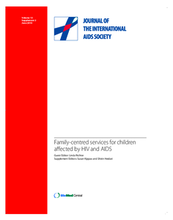AIDS is fundamentally a family disease: infections run through families, families carry the burdens of infection, and growing evidence suggests that family-centred approaches to prevention and treatment are particularly effective.
It is therefore not enough to merely provide antiretroviral drugs to mothers and children: it is critical that treatment and care for children are integrated into the broader context of family-support schemes, write Linda Richter et al, guest editors in a special issue of the Journal of the International AIDS Society, published online on Thursday, 24 June 2010.
The special issue brings together in one place – for the first time – the rationale for family-centred services for children affected by HIV and AIDS and some of the available evidence for the effectiveness of doing so, in what the authors hope will signal the start of a groundswell of interest in family-centred services for children affected by HIV and AIDS.
“At its heart, AIDS can be thought of as a family disease. In areas where there is a high-prevalence of HIV, transmission occurs mainly in the family, between parents and children born from that relationship, and between partners and spouses. Families are also on the front line of prevention, providing education and reinforcing risk reduction, especially among young people,” writes Richter in the introductory article to the series of nine articles.
It is now clear that the infection of an individual ultimately impacts on the structure and functioning of entire family. The loss of income incurred when an HIV-infected parent becomes ill, the burden of healthcare expenses, and the psychosocial stress associated with this disease all transcend individuals, says Richter.
“AIDS throws families into crisis, causing anxiety and stress wherever it occurs. The full impact of HIV and AIDS, including its social and economic effects, is only appreciated when the family, and not only the individual, is the unit of analysis.
“Families, defined in an inclusive way, can and should play a central role in delivery of treatment, prevention and care for children, and family members should be involved in the decision making for any health-related intervention”, Richter asserts. This approach is critical to meeting the challenges of a growing epidemic, and is valuable even in working with the most marginalised groups, such as sex workers, men who have sex with men, and injecting drug users, many of whom have families and children.
Yet, pitifully few resources and services are directed at bolstering and protecting this front line. Fewer than 15% of families caring for orphans and vulnerable children in 2007 were estimated to have received any assistance from external agencies. Recognition of the role that communities play in supporting orphaned and vulnerable children, and the importance of strengthening community-based systems of care has also been slow to emerge, Richter says.
Still, there are indications of change. During recent years, donors have increasingly recognised the need for programmes that specifically target families. Models of the prevention of mother-to-child transmission of HIV (PMTCT) have been developed to provide comprehensive care and treatment to HIV-infected, pregnant women and members of their families. Increasing numbers of home-based HIV counselling and testing and treatment programmes are being implemented and are gaining ground.
To further strengthen these and similar programmes, international community now needs to reshape its thinking and construct targeted approaches that build on the strengths of families and provide support in a framework for the benefit of the entire family.
The articles in this issue have been solicited through The Road to Vienna, an initiative led by the Coalition on Children Affected by AIDS (CCABA), in preparation for the upcoming XVIIIth AIDS Conference to be held in Vienna. The initiative brings together a number of foundations and other partners committed to the wellbeing of children, and aims to facilitate generation of evidence for family-centred services, as well as promoting their implementation.
This special edition explores the various elements and dimensions of families affected by HIV and AIDS within a range of contexts. It includes the historical background of thinking around family-centred services; a review of the evidence for family-centred models of PMTCT; a systematic review of the impact of family-centred HIV treatment models on children’s health outcomes; family approaches to prevention among young adolescents; the families and children of men who have sex with men and injecting drug users; men as fathers, and their desire for fatherhood and paternal roles; and maternal depression as another example of where family-centred models are needed.
By publishing this special issue, the authors hope to make an important contribution to the discourse around the prevention and treatment of HIv, targeting the broader public including community members, policy makers, funders and researchers. Readers have the opportunity to comment on individual articles by scrolling to the end of the article on the website.

